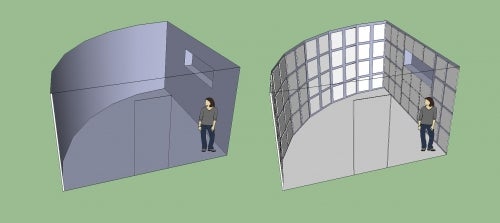If you would like to see more information on this case study, click here!
You can request this case study and a WCDE staff member will get back to you.
CanmetENERGY, part of Natural Resources Canada (NRCan), is involved in research and development for clean energy technology that reduces greenhouse gas emissions and the impacts of climate change. CanmetENERGY focuses on areas such as infrastructure, industrial processes, and transportation. The Renewable & Integrated Energy Systems Division, located in Ottawa, Ontario, is currently improving one of their own office buildings, originally constructed in the 1970’s, as a pilot project to meet ISO 50001 standards. The goal of ISO 50001 is to promote systems and processes that will improve energy efficiency and reduce consumption. One focus for this project is the poor insulation of the building, which results in high space heating costs. An insulation solution that could be implemented on the pre-existing building was desired. Due to the minimal space available, Vacuum Insulation Panels (VIPs) were chosen for their low profile and high insulation performance. A single office was selected to analyze the effectiveness of VIPs. The chosen office was a corner room, with two outside walls. If the results from the VIP installation of this office proved successful, CanmetENERGY could promote this implementation for energy improvements, and continue the implementation of VIPs for the entire building.
Basil Khan, while employed as an engineering co-op student at CanmetENERGY, was asked to evaluate the benefits and drawbacks of incorporating VIPs in Canadian housing construction based on the pilot project. NRCan has licensed the publication of the data used in this case study. NRCan scientists will publish a final analysis of this research in 2014-2015.

3D depiction of proposed placement of VIPs
The main objective of this case study is to illustrate the application of heat and mass transfer, and analyze the use of vacuum insulation panels in order to determine if this material choice is effective in reducing energy consumption and costs. This will require the students to follow ISO 50001 standards, and to understand concepts of heat transfer and sustainable design.
If you would like to see more information on this case study, click here!
You can request this case study and a WCDE staff member will get back to you.
Contact Waterloo Cases in Design Engineering
Steve Lambert
Tel: (519) 888-4728
Email: steve@uwaterloo.ca
The University of Waterloo acknowledges that much of our work takes place on the traditional territory of the Neutral, Anishinaabeg, and Haudenosaunee peoples. Our main campus is situated on the Haldimand Tract, the land granted to the Six Nations that includes six miles on each side of the Grand River. Our active work toward reconciliation takes place across our campuses through research, learning, teaching, and community building, and is co-ordinated within the Office of Indigenous Relations.